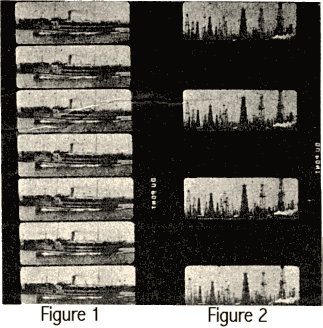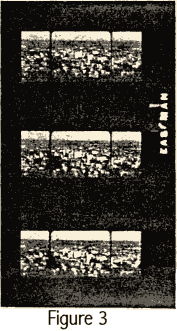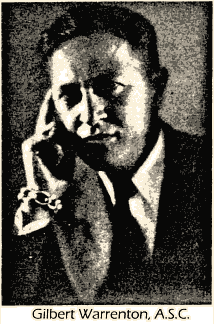FOR the past thirty years, the physical form of motion picture films and apparatus has conformed to a single, universally accepted standard. During that time, the motion picture has grown from a penny-arcade concession into the world's major entertainment; from a novelty into a major industry. And the foundation of that growth lay in the fact that a motion picture, no matter where it was made, could be reproduced in any other place, on any projector. Whatever might be the artistic form of the picture, its physical form was so standardized as to give it the possibility of world distribution.
Today the motion picture industry is seriously discussing a radical departure from these existing standards of physical form. It is discussing the use of a considerably wider film, bearing a picture of radically different proportions, and moved by perforations of an entirely different size and pitch. Furthermore, it has as yet determined upon no set standard for these new dimensions. Some experts advocate a film 70 mm wide; some advocate one 65 mm wide; some favor one 50 mm wide; while others prefer one merely 40 mm wide. Furthermore, while all are agreed upon a change in the proportions of the present picture, there is no unanimity as to the correct proportion; some advocate a ratio of 3 to 6; some one of 3 to 5; some one of 3 to 4 1/2; while others are satisfied with a return to the old silent standard of 3 to 4. In a word, there is no agreement save in disagreement. Almost every producing organization has its own preferred standard, and in the present competitive situation, there is little hope for eventual agreement.

To the non-technical observer, this may appear to be a vast deal of bother over insignificant details. But just what will be involved in such a change in the physical dimensions of the film? The answer is - everything. Everything that in any way contacts the film from its origin in the factory to its destination on the screens of the world's theatres will be affected. In the factory, the slitting, perforating, and packing machinery will have to be altered or replaced. In the studio, the cameras, magazines, cases, rewinds, moviolas, splicers, projectors and recorders will have to be replaced or altered. In the laboratory, the developing machines, racks, and tanks, the printers, the rewinds and splicers, the polishers, and waxing machines will have to be changed. In the theatre, the projectors, sound-heads, rewinders, splicers, and screens will have to be renewed. And in between these places, the very shipping cans, boxes and reels will have to be replaced.
Obviously, the cost of such a far-reaching change would be tremendous. A recent, conservative estimate places this figure in excess of $250,000,000.00. In addition to this, the additional cost of the film stock for release prints alone has elsewhere been estimated at more than $10,000,000.00 annually. And these vast sums are to be expended by an industry which has only recently sunk $500,000,000.00 in sound equipment, and in the face of a steadily decreasing business!
Now, granting that some definite standard of wide-film dimensions be adopted before the industry takes this epochmarking step, what benefits can possibly be expected?
Firstly, the larger frame will permit the use of larger screens, and larger theatres. It is claimed that the ultimate limit in projection enlargement for the present standard film has now been reached in the larger theatres, and passed in such houses as the Roxy and Paramount. BUT - more than 90% of the world's theatres are of less than 1,500 seat capacity.
Secondly, the novelty of the larger screen will have a stimulating effect upon the box office. BUT-the public has proven that it is interested in entertainment, not in technical novelties. If any doubt of this fact exists, consider the increasingly marked public interest in good, silent pictures, as against the once-profitable novelty of 'talkies.' Furthermore, the proponents of natural-color cinematography have repeatedly argued that the public would overwhelmingly approve of color -which is a far more noticeable technical feature than a large screen-and the public has repeatedly proven itself as apathetic regarding color as it was expected to have been enthusiastic.
Thirdly, the wider frame will give the director and cinematographer a more natural, a more dynamically proportioned picture with which to work. To this writer's mind, this is the only irrefutable argument in favor of a wider film. BUT-is this purely artistic consideration of sufficient practical value to entice an additional ten million dollars through the box office window each year-to say nothing of repaying the staggering cost of replacing a world's cinema apparatus?
Furthermore, is it necessary to change to a wider film to gain the advantages of a wider screen?
Approximately five years ago the increasing size of American theatres first brought to light the need for larger screens. At that time the experiment of using shorter-focus projection lenses, which resulted in a larger projected image, was tried. This was first used, I believe, in the roadshowing of "Old Ironsides," and was exploited under the trade name of "Magnascope." Practically the only difficulty encountered was in the fact that the increased enlargement increased the granularity of the projected image to a more or less objectionable degree.
Since then vast strides have been made in the resolving power of both negative and positive emulsions, and in the methods of processing film. Recent experiments have shown that the only limiting factor to the size of the projected image is the resolving power of the negative film With the introduction and perfection of machine development of negative-a development largely due to Mr. C. Roy Hunter, Superintendent of the laboratory of the Universal Film Company-this resolving power has been increased to an extent which makes the use of larger screens not only possible, but practicable. Proof of this is the fact that at the Carthay Circle Theatre, in Los Angeles, the first picture to be released upon a wider film was immediately followed by Universal's "All Quiet On The Western Front," many sequences of which were, by means of the Magnascope, enlarged to identically the same size as had been employed for the previous wide-film picture, with no loss of photographic quality, and without any traces of either the weaving or the optical aberrations which have prominently characterized the wide film pictures. Furthermore, in at least one of the smaller theatres in the Los Angeles district (the Gateway Theatre, in Glendale) the management makes a regular practice of similarly enlarging every feature picture played, and, further, of using a special projection-aperture which masks the frame off to the accepted 3 x 6 Grandeur proportion. According to several impartial observers (among whom may be named Karl Struss, A.S.C.), absolutely no loss in photographic quality is noticeable in the projection in this theatre. In fact, the first picture with which this practice was followed was the 35 mm version of the wide film picture which was just referred to. So successful was this method of widescreen projection that no difference was noticeable between the quality of the original wide film version and that of this synthetic wide screen experiment. The only difference lay in the fact that, due to the different proportions of the normal 35 mm Movietone frame and the 3 x 6 aperture used to achieve the wide-screen effect, in close shots heads and feet were sometimes cut off rather more abruptly than was originally intended. However, this difficulty could in a great measure be remedied by careful framing by the projectionist.
However, from an artistic standpoint, this question of composition is a somewhat serious one, particularly in the case of close-ups of a big head, where the head may be cut off at the eyebrows or chin. For the composition of such a close-up-or of any other shot, for that matter-is often a vitally important part of the scene, and anything that damages that composition is in no inconsiderable degree damaging the picture as a whole.
But this situation is bound to repeat itself as long as a picture composed primarily for a 3 x 4 proportion is reduced to a 3 x 6 format. The logical remedy for this would be to compose the picture primarily for the 3 x 6 rectangle, and secondarily for the 3 x 4: in other words, to advance the present general practice of composing for both the silent (disc) and Movietone standards, by using a frame reduced to a 3 x 6 proportion, and centering the action in a 3 x 4 area in the center of the larger frame.
Some five years ago this writer witnessed an experimental showing of a wide-film process using 3 x 6 proportion. As a practical cameraman, he could not help but appreciate the artistic value of the wider frame; but, as a practical cameraman, he could not help, either, but see the tremendous disadvantages of a changed film-size. Therefore he set himself to the problem of securing this more desirable proportion without change of film dimension.
In these researches the object was to produce a picture of 3 x 6 proportion on standard 35 mm. film, but at all times keeping the main story-telling action in the center of the screen in a 3 x 4 proportion (see figure 3), by doing this it would be possible at any time to make an enlarged picture standard size and proportion from this negative without making any other change.
At this time the writer learned that Mr. C. Roy Hunter was working along a similar line and in combination with his laboratory achievements, these researches have now been carried to a successful fruition, and it is with pardonable pride that he is able to state that he has been able to secure, upon standard 35 mm. film, a wide screen image which combines all of the artistic and technical advantages claimed for wide film, with none of its disadvantages, and with the proven optical superiority and production practicability of standard 35 mm film.

In so far as the photographic apparatus is concerned, the only change required is the substitution of an aperture of reduced height: .360" instead of the present standard of .720". This, when the standard .07" sound track is used, gives a picture-proportion of 3 x 6. This frame may be used as in figure 1, with the camera mechanism adjusted to a pull-down of but two perforations at a time, or as in figure 2, with the camera mechanism unchanged. Inasmuch as the latter procedure allows the projection of the film in any standard projector, with only the addition of the reduced aperture-plate, it is probably preferable. An outstanding advantage of this method of making wide screen pictures is that it not only allows the use of present standard apparatus throughout, unchanged save for the reduced apertures in camera and projector, but that it gives sharper negatives, by virtue of the fact that the longer focus lenses demanded for wide film photography are not needed, This obviously results in a far greater depth of focus, which, in turn, augments the pseudostereoscopic effect given by the wide screen. In wide film photography, the minimum focal length usable is a 50 mm., whereas by using the reduced aperture, any lens practicable for use in normal 35 mm cinematography may be used.
A further advantage is that this method makes possible the immediate production of wide screen pictures in natural color, by the Multicolor, and allied processes
In so far as the laboratory processing of films made for this use is concerned, there need be no difference from the standard high quality machine development now in vogue. Due to the refinements of control, etc., which Mr. Hunter has introduced in the procedure of machine development, negatives of high quality and extremely fine grain are produced, which makes it possible to project these small images to any size thus far attempted with wide film.
To briefly summarize the advantages of this method of making wide screen pictures on 35 mm. film: no change of apparatus is needed, beyond the reduced aperture-plates used in cameras and projectors. Further, every artistic and technical advantage claimed for wide film is gained, while the optical and production superiority of 35 mm. film is preserved. In addition, by use of the bi-pack color processes, wide screen natural color is immediately available. And finally, since figures are always more eloquent than words, this method will result in a direct saving to the industry of not less than $250,000,000.00 in comparison with the use of any wide film process, not to mention the saving of $10,000,000.00 annually on release prints. And it is immediately applicable to production conditions.

Editor's Note: Gilbert Warrenton, the writer of the above article is one of Hollywood's best known cameramen. He was born in Lake View, New Jersey, March 7, 1894. His parents were stage players, so, as he puts it, he was educated in a Taylor trunk as he journeyed from city to city. He was always interested in photography as a boy and used to annoy the stage property men with his equipment. In 1912, he decided to come to Hollywood. He broke in as an assistant cameraman and in two years' time had become a full-fledged first cinematographer. His first job was at Universal He hopped around among Universal, Triangle, First National, Famous Players and various others during the passing years, but spent most of his time with Universal. Among his outstanding pictures have been "Humoresque" "Under the Red Robe", "The Cat and the Canary", "The Man Who Laughs", "Mother Knows Best", "Captain of the Guard" "Showboat," and he has recently completed "Motherís Cry".